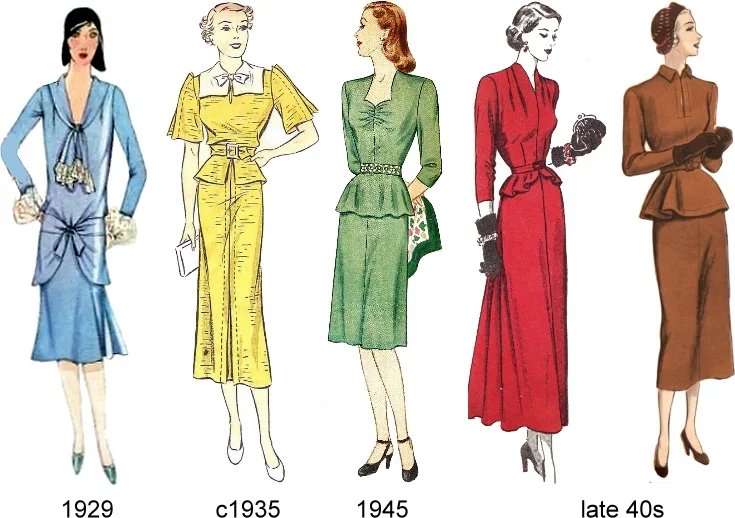I’m revisiting posts from the Tuppence Ha’penny archives, and in some cases updating and expanding the content. This one is part of a series I first published back in 2011, part of the “Vintage for Beginners” series.
As you start building your wardrobe it's worth investing in one or two so-called 'background' dresses, which you can accessorize for a variety of looks. "Background" doesn't have to mean "boring": The background dress's simplicity means it's a blank canvas, and you can go wild with different colour schemes and accessories for a different mood each time. You can play with eras (paired with dainty gloves and a snood, that shirtwaist is 40s; switch those out for a wide-brimmed floppy hat and knee high boots, and it becomes 70s) and adapt it to a variety of occasions: changing your shoes and hairstyle take a swing dress from casual to cocktail.
The background dress can be solid-colour, colourblock, textured or a non-dominating print such as polka dots, ginghams and plaids. For maximum versatility, go for monochromatics - which isn’t to say neutral: my background colours are coral, teal and navy blue.
Here, I explore how some basic dress styles evolved through the decades from 1920s-1960s.
The Shirtwaist
When it first appeared in the late Victorian era, a shirtwaist was a type of women's blouse ("waist" meant bodice or blouse) inspired by men's tailoring and free from the elaborate ornamentation that was common at the time. Gradually the term came to mean a one-piece dress with a shirt-like, collared bodice. Shirtwaist dresses can button from neck to waist seam, or through to the hem. Traditionally they are daywear, though 1950s versions in silk and acetate taffetas made the transition to cocktail wear.
The Pinafore or Jumper Dress
As you can probably imagine, this style was originally conceived as workwear, essentially an apron intended to protect the frock underneath. By the 1930s it had evolved into a fashion garment in its own right. It was popular during the 1940s (it was a perfect "make do and mend" project) and through the 50s in both slim and full skirted styles. The pinafore had a complete makeover in the late 60s and early 70s at the hands of designers such as Mary Quant, who created A-line, mini length versions and daring cutaway variations. Whichever era you choose, a pinafore/jumper dress is great daywear, which will take you from early autumn through to next spring just by changing what you wear with it (blouse, cashmere sweater, cardigan).
The Peplum Dress
The fashion peplum has its origins way back, as a detachable flounce intended to give a little extra emphasis to one's bustle. Some flapper frocks featured similar flounces to their dropwaist dresses in the 1920s to add swish to their charleston, and peplum styles continued into the 30s. The 1940s saw a real heyday for peplum dresses exaggerating the nipped-in waist, with short peplums, long peplums, asymmetrical peplums, flounced and flat, draped and tiered peplums, peplums which tied sarong-style at the waist. In the early 1950s the peplum one-piece dress drifted from popularity, although peplum suit jackets were wildly popular. Peplum dresses enjoyed a huge resurgence in the 1980s, then faded into obscurity during the 90s, only to re-emerge once again in the late 2000s.
The Drop-Waist Dress
Drop-waist dresses are of course most closely associated with the 1920s, but by no means did they end there. Towards the end of the 20s waistlines moved back up toward the natural waist, and remained there through the 30s, but in the mid-40s a new style of dropped waist emerged, slim fitting over the waist and hips then flaring into an A-line or gathered skirt. These fitted drop-waist styles remained popular through the 50s. Fashion started de-emphasising the waist once more in the late 50s - early 60s in the boxy silhouette associated with the "Mad Men" period, paving the way for a revival of the 1920s loose-fitting drop-waist. Late 60s and early 70s mod fashions featured drop-waists as an alternative to the simple shift. The drop-waist enjoyed another resurgence in popularity during the 1980s.
The Princess Dress
A princess dress is one in which the shaping is achieved through vertical panelled construction rather than darts, and have no waist seam. Usually seamed from either the shoulder or the armscye, although some of the examples above are a variation on the princess construction.














